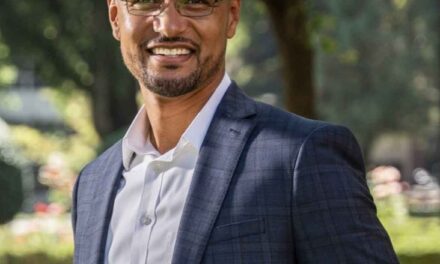Heirs of Bruce’s Beach Finalize Sale of Property Back to L.A. County
On Jan. 30, the heirs of Bruce’s Beach finalized the sale of the land they just reclaimed last year back to Los Angeles County for $20 million.

Antonio Ray Harvey | California Black Media
On Jan. 30, the heirs of Bruce’s Beach finalized the sale of the land they just reclaimed last year back to Los Angeles County for $20 million.
Antonio Moore, a Los Angeles attorney and co-founder of the American Descendants of Slavery (ADOS) movement, says the deal reached by the heirs of Bruce’s Beach “doesn’t seem to be at fair market value.”
In his Jan. 6 podcast, which can be viewed on Youtube, Moore said he crunched the real estate numbers of surrounding property in Manhattan Beach and claims that the land is worth more than the $20 million – the price at which the heirs of the controversial property were offered for the land.
The attorney said the option to sell back the land, which was first purchased in 1912 and illegally acquired by the city, is akin to the financial loss Black Americans have experienced over the decades due to “housing discrimination.”
“In essence, we are going to give them back the property but not assess any of the generational costs,” he said. “And then we (the county of Los Angeles) are going to create all types of limitations on the way they can access and use that property.”
Moore continued by saying, “The fact that this was sold back for $20 million should have everyone in an uproar. The fact that the (California) Reparations Task Force has literally said nothing about this is abject failure in my view.”
Moore said in his 37-minute podcast that no one really took the time to “contextualize” the agreement between the county and the Bruce family since the announcement was made. Houses and condos around Bruce’s Beach are priced at around “$3 or $4 million dollars,” he said.
According to Realtor.com, Manhattan Beach in Los Angeles County consists of five neighborhoods. As of Jan. 22, there were 57 homes for sale, ranging from $1.2 million to $22 million. As of July 1, 2022, 34,668 people resided in the beach town located about 30 miles southwest of Los Angeles. Of that number, 74.8% are White and 0.5% are Black, according to U.S. Census Bureau numbers.
“I am not here to attack this family,” Moore said of the Bruce family. “I am more so here to question how we got here.”
The Bruce Family’s attorney George C. Fatheree III told KBLA radio personality Tavis Smiley that the family was prompted to sell because it faced a long and drawn-out process to get approval for development by the city of Manhattan and the California Coastal Commission.
“The return of the property and the ability to sell the property and take funds and invest it in a way that’s important to their lives represents an important opportunity for my clients to get a glimpse of that legacy that was theirs,” Fatheree said.
The disturbing story of Bruce’s Beach Park — the location of the first West Coast seaside resort for Black beachgoers and a residential enclave for a few African American families — has received worldwide attention.
One hundred years ago, Manhattan Beach city officials seized Charles and Willa Bruce’s beachfront property through eminent domain, citing an “urgent need” to build a city park.
The use of eminent domain was the end result of segregation, intimidation, violence and threats from the Ku Klux Klan in Manhattan Beach. The plot of land that attracted Black people from all over the country was not developed for recreational use after it was forcefully taken from the Black owners.
On April 9, 2021, Los Angeles County Supervisor Janice Hahn announced the return of the land to the Bruce’s descendants. The Bruce’s purchased the real estate in 1912 for $1,225.
The transfer of ownership of the land was able to be completed with the help of legislation authored by state Sen. Steven Bradford (D-Gardena). Senate Bill (SB) 796 exempted the Bruce’s Beach property from state zoning and development restrictions and enabled the county to return the site to its rightful owners.
On Sept. 30, 2021, Gov. Gavin Newsom signed off on SB 796, allowing the Bruce family to retain property that has appreciated in value over the last century.
Two options sat on the table for the heirs. LA County was in line to lease the land for $413,000 per year. It also included an exchange to buy the land for as much as $20 million. The family took the latter.
After the news of the decision to sell the land back to the county broke, social media exploded with commentaries from the Black community – for and against the sale.
Opinions on Twitter ranged from, “they got hustled,” the family “knew they’d sell back the property due to taxes,” “I wish they could have reached out to grass roots for direction and assistance,” “sad,” “unbelievable,” to “This was theirs to sell in the first place. Why are we acting like this was ours?”
Holly J. Mitchell, L.A. County Supervisor for the 2nd District, stated in a Jan. 3 press release that she was “proud” that the county and state addressed the “systematic racist acts that have cost Black families generational wealth.”
“I fully support the self-determination of Black people and families like the Bruce’s to decide what is best for their lives and legacy,” Mitchell stated. “I will continue to advocate for the Bruce family to be fully informed and prepared for the immediate and long-term implications of this sale.”
Considering the well-documented history of racism in housing and real estate that have affected Black Californians, Bruce’s Beach draws attention to other areas in the state where discriminatory laws or practices that have caused Blacks to be illegally displaced or to lose valuable property. Many of these incidents have been highlighted by the California reparations task force.
Examples include land once owned by Black pioneers in Coloma, where the Gold Rush started in 1848; the removal of African Americans from their homes in downtown Santa Monica; and Black community loss of property in Russell City, located between Hayward and Oakland.
“The return of Bruce’s Beach to the rightful heirs of Charles and Willa Bruce will continue to serve as an example of what is possible across the globe when you have the political will and leadership to correct the injustices of the past,” Mitchell added.

Antonio Ray Harvey
Antonio (Tony) Ray Harvey was born and raised in Champaign, Illinois, but has resided in Sacramento, California for 32 years. He graduated with a Bachelor of Arts degree in journalism and a minor in photography from California State University, Sacramento.
Aside from reporting on local entertainment, community issues, city government, and political events at the California State Capitol, Harvey is also a freelance sports journalist in Northern California. He covers the National Basketball Association, the National Football League, and NCAA sports.
Harvey is a freelance reporter for California Black Media, is also the author of the Homicidal Handyman of Oak Park: Morris Solomon Jr. at Johnston College on the University of Redlands Campus 1974-76 and recently was awarded a Doctorate of Humane Letters from CSUSB in 2014.











